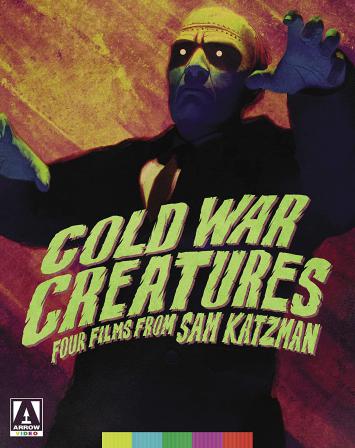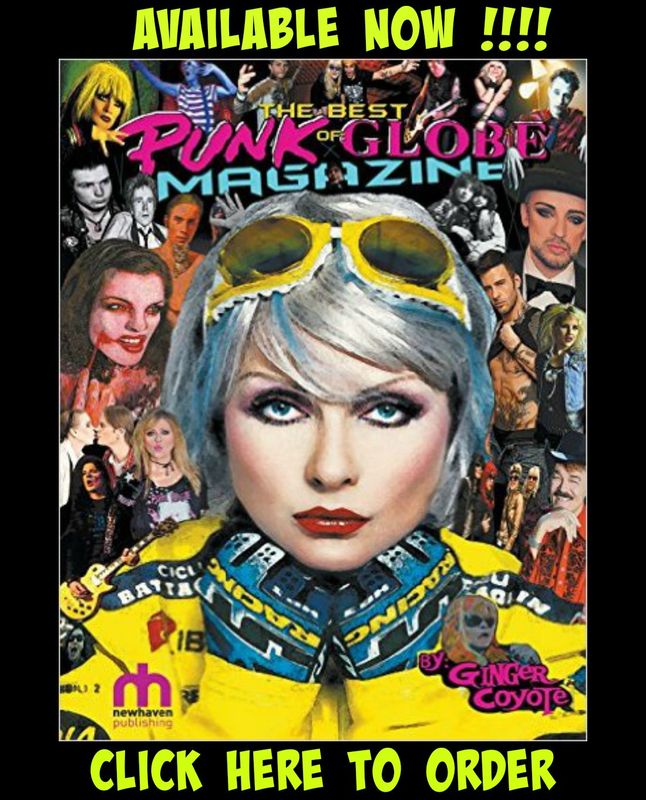Sam Katzman was an interesting cat. He started in the film business at the very bottom when he was still a teen and made sure to learn as much as he could about as many aspects of the film biz as he could while he made his ascent. With a keen eye on how to produce films on the cheap he produced features and serials at the legendary Monogram Studios including the films co-starring Bela Lugosi and The Eastside Kids. He established a relationship with Columbia Pictures and in the mid-50’s he began making monster flicks catering to teens who were spending lots of money at the drive-ins. Four of these titles, Creature With The Atom Brain, The Werewolf, Zombies Of Mora Tau and The Giant Claw were previously released in the Icons Of Horror DVD box and have now been given the Arrow treatment on Blu-ray in a new box set loaded with great new extras.
Disc one features Creature With The Atom Brain. This is a tight little potboiler and it’s quite enjoyable. Mixing a revenge plot with atom age science, the creatures are different and have a great look with the scars around the cranium. A nice hybrid shocker directed by Edward L. Cahn who would later go on to direct the classics Invasion Of The Saucer Men and It! The Terror From Beyond Space.
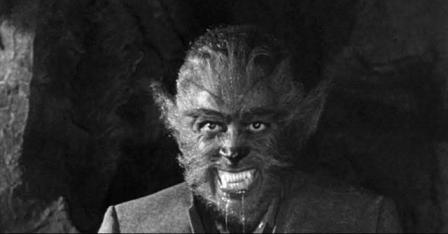
Disc two features The Werewolf and with Katzman concentrating on atomic science, this wasn’t your average full moon lupine creature. Working from a deep emotional base this film, directed by Fred F. Sears, really connects with earnest acting, nifty special effects and a solid performance by the leading man/wolf. Sears has an interesting resume as he started out directing a biography of Al Jolson and then did a string of westerns. Also in his filmography are musicals like the Rock N’ Roll classics Rock Around The Clock and Don’t Knock The Rock along with Cha-Cha-Cha Boom! with Perez Prado. Sears conjures up some heart wrenching scenarios with the well-meaning townsfolk making tough decisions, the wolf’s heartbroken wife and son and the wolf himself. Played by Steven Ritch, this tortured soul has had lycanthropy inflicted on him by unethical scientists experimenting with atomic radiation. Like most werewolf tales this is a tragedy and Ritch is highly effective as a different kind of lycanthrope who can roam in daylight and only wolfs out when threatened. The opening sequence of him entering a bar looking in bad shape, being very confused and running afoul of the local tough guy evokes film noir while the finale with a mob of locals hunting the wolf down with torches is a nice nod to the Universal films.
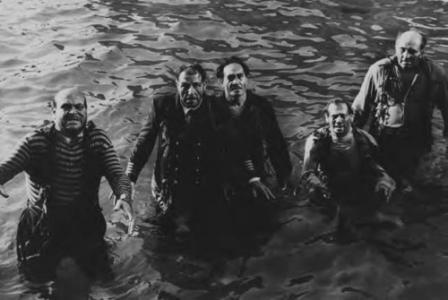
Disc three features Zombies Of Mora Tau and this film returns us to the world of the supernatural. In the wake of George A. Romero redefining what a zombie was capable of, movies like this tend to be brushed aside but this is one that really holds up and features some excellent undead imagery. Directed by Edward L. Cahn he makes Africa seem like a gloomy place as most of the scenes either take place at night or under the murky depths of the sea. Speaking of Romero he would pay visual tribute to Mora Tau’s aquatic zombies in his own Land Of The Dead. And while other films feature zombies emerging from or under water, the scenes of the undead sailors attacking the deep-sea divers in this film are unforgettable. There is also a very good cast on deck including Allison Hayes of The Attack Of The 50 Foot Woman and Gene Roth, the “Give me that fillum!” guy from the Three Stooges.
And finally disc four tries to contain la Carcagne, the colossal bird bearing The Giant Claw. Loved by fans of bonkers cinema and loathed by people who would refer to this type of film as a golden turkey, The Giant Claw needs to be part of this set just to even things out as far as telling a story about Sam Katzman. Figuring on adding some Ray Harryhausen type stop-motion animated special effects, he couldn’t afford the now successful Harryhausen and instead hired some effects artists who took a different approach. More than likely due to budget restraints a puppet was used to represent the creature and while impressive on one level it is laughable on another. Still, the film has always been late night fun and deserves some respect. And it’s got Mara Corday in the cast and that is always a good thing.
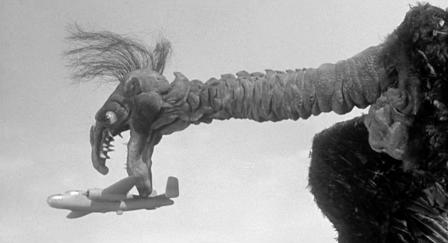
The films all look and sound great with fun, new extras. Included are introductions by author Kim Newman, commentaries, Super 8mm versions, trailers and new feature length overviews by various personalities including artist Stephen R. Bissette. His feature length look at Sam and his films is not only excellent fun but highly informative. Stephen generously took some time to discuss the films in this set with me.
Punk Globe: I consider 3 of the 4 films in the box set to be several steps above your average drive-in flick. Do you think Sam was trying to step up his game or would you say the movie gods were smiling upon him and sent him quality craftsmen on these?
Stephen: Well, define "average drive-in flick" circa 1955-1957—I mean, just about all the Hollywood and off-Hollywood fare in circulation those three years hit the drive-ins eventually, from the mainstream big studios to the completely threadbare loopy fare coming out of the hills and hinterlands. I'd argue all four films are cosmetically equal to or better than comparable genre fare from other outfits, and if you actually matched them with their original co-features (IT CAME FROM BENEATH THE SEA, EARTH VS. THE FLYING SAUCERS, THE MAN WHO TURNED TO STONE, THE NIGHT THE WORLD EXPLODED), Sam Katzman was providing fair 'bang for the buck' given the under-$200,000 budgets these films were actually made for.
Katzman was always "upping his game" as a huckster—selling the sizzle, while investing as little as possible into his 'steaks'—and in making money for himself and his then-current parent studio, Columbia. That was his criteria as a producer, so I think it only fair to first consider that as a means of assessing the relative value of these films, in the context of their times. Having been at it since the 1930s, working his way up from his own outfit in the 1930s to co-producing with Jack Deitz via their Banner outfit for Monogram in the early 1940s, to stepping to the Columbia partnership by 1946 and benefitting from the considerable studio resources the Columbia deal offered him, Katzman had become very, very proficient at pulling together the best talent he could or would afford while making the most of what-was-in-reach: stock footage, standing sets, backlots, already-paid-for available costuming, etc. Working from often variable and quickly cobbled-together scripts, directors like Edward L. Cahn and Fred F. Sears delivered polished, professional, and steadily paced narrative features that were efficiently shot, edited, and completed. Everyone did their part, and these are all smooth rides.
The accidental fringe benefits are gravy: the occasional genre innovation, like science-fictional zombies in CREATURE WITH THE ATOM BRAIN, or (as Kim Newman points out in his introduction to the film in this set) ZOMBIES OF MORA TAU introducing the first 'contagious' zombification, weren't anything Katzman demanded of his writers, directors, cast or crews. In hindsight, we can recognize these as innovations, but they weren't intended as such: they were, at best, novelties, or novel 'spins' on tried-and-true material Katzman had already milked for Monogram a decade earlier. That said, a gem like THE WEREWOLF is more than a happy accident: everything came together on a film like that to make something unique—modestly unique, yes, but unique and in its way quite original in 1956, and arguably another innovator in and of itself.
I'd argue two of the original co-features of two of the films in the set were the only truly innovative works Katzman executive produced in the sf/fantasy/horror genre in the 1950s, and that was because Katzman essentially stayed out of the way of up-and-coming producer Charles H. Schneer and especially hungry-to-blaze-his-own-career-path Ray Harryhausen, the extraordinary stop-motion animation artist. Along with Warner Bros. THEM!, IT CAME FROM THE BENEATH THE SEA was the first and best of the successors to THE BEAST FROM 20,000 FATHOMS (1953), and EARTH VS. THE FLYING SAUCERS was the only Katzman genre fare to actually deliver more than its posters and ballyhoo promised.
Punk Globe: Would you say CREATURE WITH THE ATOM BRAIN was a worthy addition to the "gangster/horror" genre?
Stephen: Yes, absolutely. I think the film holds up really well as an unusual crime outing and a lively, action-packed sf exploitation film. There was a procession of sf 'zombie' films around the same time, released within a year or so of CREATURE WITH THE ATOM BRAIN—THE GAMMA PEOPLE, QUATERMASS II aka ENEMY FROM SPACE, etc.—but CREATURE has a number of elements that hadn't been part of the previous Caribbean-set zombie movies, including the high-tech (for 1955) remote point-of-view monitor shots from the perspective of the mind-controlled stooges and (as I note in my text piece on the film in the set booklet) unusually explicit on-camera ballistics mayhem (tearing into and through zombie bodies). Part of the "gangster" element of the genre fusion is the more naked aggression of the violence in the film, which had to have been harsh for a 1955 audience: the back-breaking attack, in silhouette; the escalating armed responses having no real effect on the relentless dead; that still-creepy sequence with the little girl, ending with the shot of her dismembered and beheaded doll lying on the floor. Strong stuff in its day, and arguably the first real step towards what George Romero would do with far, far greater intent and intensity in 1968's NIGHT OF THE LIVING DEAD.
Punk Globe: I like that you pointed out that THE WEREWOLF is a "western" at heart. It's one of my favorite werewolf flicks. How do you feel it rates in the realm of werewolf films?
Stephen: I think THE WEREWOLF is a terrific movie, to my mind the best American werewolf movie released between THE WOLFMAN (1941) and Joe Dante Jr. and John Sayles' THE HOWLING (1981). Given the usual Katzman tight resources of time and money afforded director Fred Sears and his cast and crew, they really pulled off something extraordinary. Steven Ritch gives such a solid performance as the lycanthrope, but I think the whole thing works: Don Megowan's stoic sheriff, the interplay between the two villains, and above all the attention paid to the werewolf's family, his wife and son, and their confusion, sorrow, and loss. What other movie of the time tangled with that? Given the makeup technology of the day, Clay Campbell's makeup effects are very effective, and Sears makes the most of them in the transformation scene when Ritch is cornered in the cave, and smart use of 'less is more' in how Sears staged and shot the jail sequence, when the werewolf finally gets the upper hand on the mad doctor and his flunkey.
There's attention to details most shapeshifter fare botches: Steven Ritch's hapless lycanthrope ending up shoeless, for instance, and how that not only adds to his agonies when in human form but makes sense of his footprints (even recent entries like the MTV series TEEN WOLF mess up on that: human shoeprints that somehow "turn" to werewolf paw prints, and/or vice-versa, which is so stupid, do they think audiences don't notice, or what?). Right to the bitter end, THE WEREWOLF plays it straight and plays up the tragedy without tipping into being either maudlin or overly melodramatic, and that most of it unreels in broad daylight makes it all the more effective, I think. What a gem, really.
Punk Globe: After not seeing it for years I was happy with how well ZOMBIES OF MORA TAU still holds up. Do you think it gets a bad rap as far as being an old fashioned "voodoo" zombie flick seeing how modern horror fans think of flesh-eating zombies as the norm?
Stephen: Prior to 1968, zombie movies were traditionally exercises in atmosphere, not action. In fact, action-horror movies either didn't exist, or were the exception to the genre norms. 2021 viewers who have grown up with post-George Romero fare (including The Walking Dead as a TV standard) just have no idea: it was Romero's DAWN OF THE DEAD that was the game-changer, revving up zombie movies into action-horror modes that were non-existent and arguably unimaginable prior to 1978. There were a few examples between 1968 and 1978—I'm thinking of HORROR EXPRESS (1972), scripted and co-produced by ZOMBIES OF MORA TAU screenwriter Bernard Gordon—that upped the action quotient, but prior to Romero, zombie movies—the best of 'em, the worst of 'em—were slow-moving fare by their very nature. It was like a rule, almost, in the same way that vampire movies had to have crosses in them, and werewolf movies (prior to THE WEREWOLF) had to have the full moon onscreen.
I always found the slow, steady, deliberately dreary pacing and murky atmospherics part of the fun, much like the old Universal MUMMY movies. Silly as they always looked, with their faked-slow-motion movements and the Lawrence-Welk-bubble-machine "air bubbles" simulating underwater respiration of the divers, just the idea of the zombies lurking around underwater was a creepy notion, and it's all there onscreen, it's rendered believably enough, and I've always dug the look of the zombies, draped in faux-seaweed tottering around in the shadows. That they spent their downtime in that tomb, and the 'thump' when they're run over—it was like a suffocation nightmare, all slow, sluggish, slimy, and that was part of the chill factor.
See, I get why that doesn't work for contemporary viewers. But in its day, and when we used to catch this film on late-night TV, that stuff worked. We hadn't yet experienced where the zombie films went after 1968. There was no flesh-eating—even the 'ghoul' movies, like THE MAD GHOUL (1943), didn't go there. Cannibalism wasn't part of the horror films audiences could see in 1957, much less on TV in the 1960s. That all came later.
Punk Globe: Even though the puppet is ridiculous but still enjoyable, do you find that the dramatic scenes in THE GIANT CLAW work well, or would the film still be campy fun even with Harryhausen quality effects?
Stephen: If you can manage it—tough, I know—watch the first half hour and ignore the special effects inserts of la Carcagne. It's absolutely the same dramaturgy of any competent 1950s giant monster movie, just as well-played, just as straight-faced and straightforward. Jeff Morrow and Mara Corday and dependables like Morris Ankrum (as the General) delivered what they always delivered: competent, convincing performances. There's nothing remotely campy about those roles, players, or the staging.
However, the most 'camp' aspect of the film's first third or so is THE GIANT CLAW's ridiculous caricature of a French-Canadian, the character of the farmer Pierre Broussard, played by Winnepeg, Manitoba-born radio, serial, movie, TV actor (and frequent 1950s American-International Pictures trailer narrator) Lou Merrill. He had to be doing it on purpose, he's so over-the-top! It's a hilarious bastardization of Québécois accent and mannerisms, as insane as Dick van Dyke's painful "British" accent and playing in the original Disney MARY POPPINS.
Of course, by the last act of the movie, Katzman's typical cost-cutting forces everyone involved into just ridiculous play-acting. Not even Morrow, Morris Ankrum, and Edgar Barrier could make that cramped-into-that-crappy-plane-set, firing off their anti-matter popgun, remotely credible-looking.
Acknowledging all that, Kim Newman makes a key point in his introduction to the film in this Arrow boxed set: the la Carcagne puppet is an extraordinary example of early animatronics, meaning the animation of the bird's facial features. The design is ludicrous, and that's impossible to ignore, but the complex-for-a-live-action-puppet monster visage circa 1957 is pretty damned unusual and innovative for its time. I can't recall anything quite like it in any pre-1960s special effects film, much less as low budget an effort. Compare just the fluidity of the animation of the creature's features with comparable live-action monster puppetry of the next decade—Carlo Rambaldi's elaborate but unconvincing proto-animatronics for the dragon in SIEGFRIED (1957) that same year, or his later titular monster of THE MINOTAUR (1961) or the reptiles of MACISTE CONTRO I MOSTRI (US title: FIRE MONSTERS AGAINST THE SON OF HERCULES, 1962)—and I agree with Kim, THE GIANT CLAW deserves a better rep for laying groundwork for future live-action animatronics.
Stephen R. Bissette is an artist, publisher, teacher and art and film historian. His art has graced the pages of personal favorites like THE SAGA OF THE SWAMP THING, 1963 and TABOO. He currently has two new monster sketchbooks available from amazon: Thoughtful Creatures is out now, and a companion volume Brooding Creatures is available as of next week.


